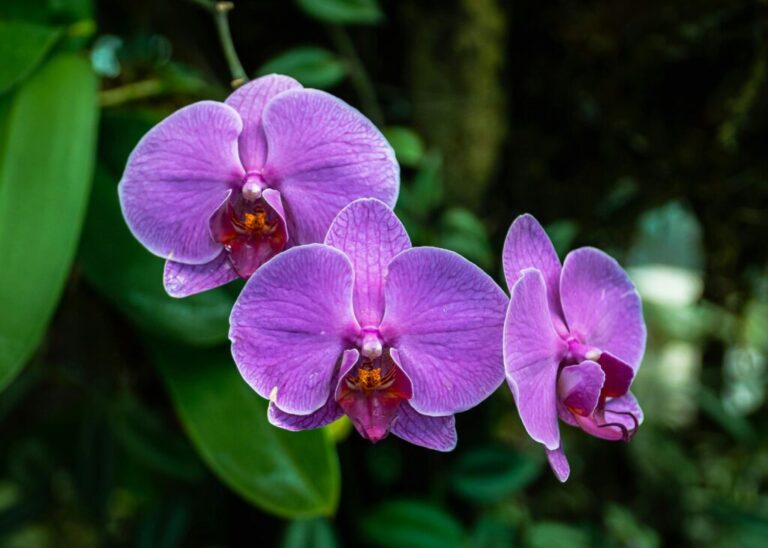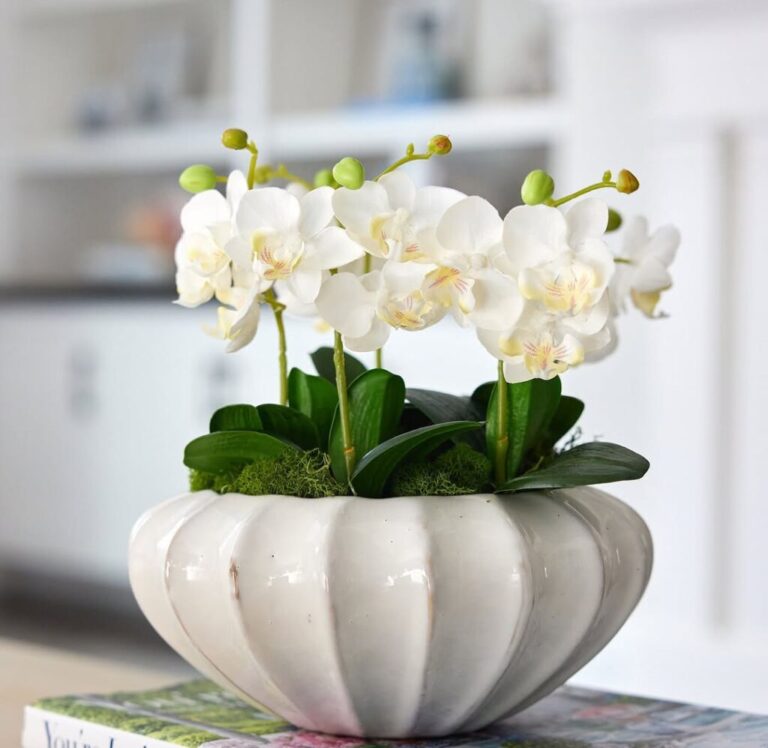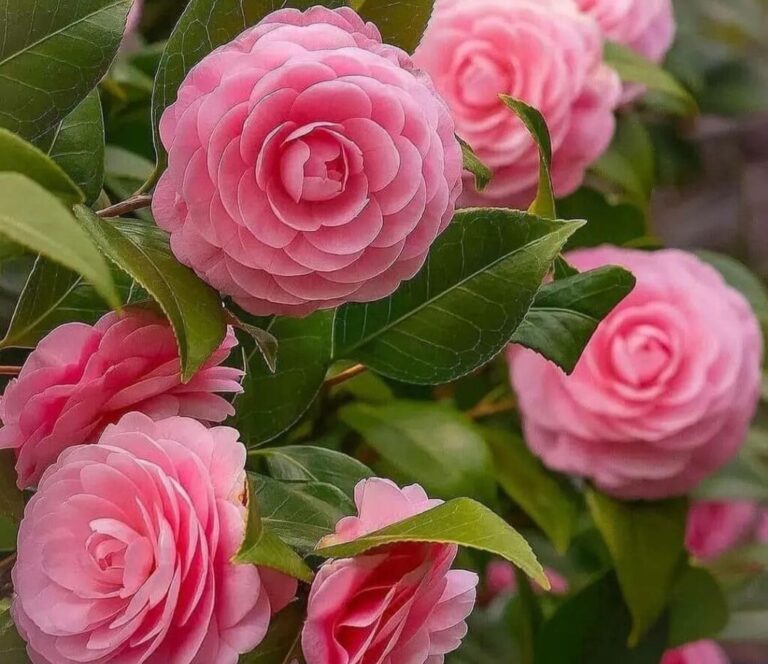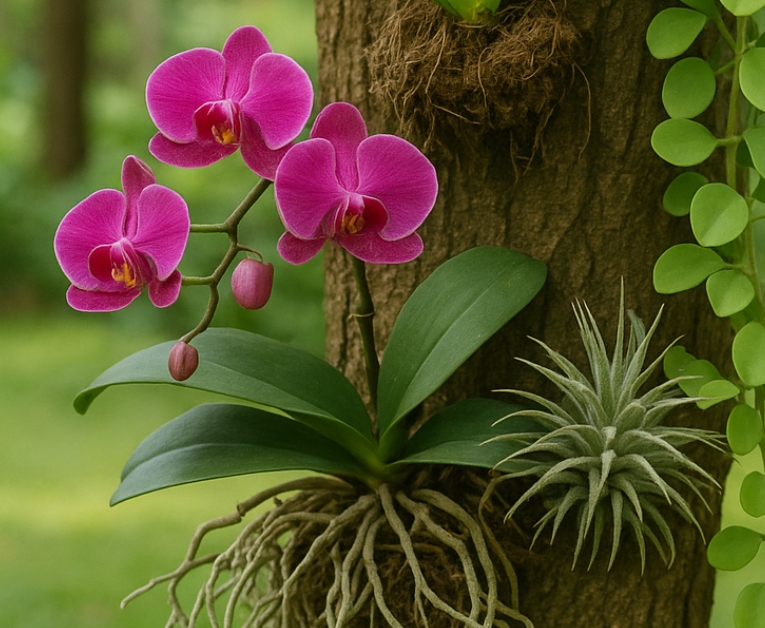- 1 Signs of Heat Stress in orchids and how to fix
- 2 How to Fix Heat Stress in Orchids:
- 3 Shade and Proper Placement:
- 4 Use Shade Cloth:
- 5 Watering and Humidity:
- 6 Mulching orchids
- 7 Use Sunblock or Shade paint.
- 8 Choose Heat-Tolerant Orchid Species:
- 9 Monitor for Signs of stress.
- 10 Ventilation and Air Circulation
- 11 Hydrate Orchids properly.
- 12 FAQ
Welcome to our latest guide on 2023 Summer Orchid Care, where we discuss essential tips and techniques to safeguard your precious orchids from the sweltering heat and potential sunburn. As summer’s scorching temperatures approach, orchid enthusiasts like you must gear up with the right knowledge and strategies to ensure your stunning blooms thrive despite the challenging conditions.
In this post, we’ll explore the best practises for shielding your orchids from heat stress and sunburn, empowering you to maintain their health and beauty throughout the hottest season. So, let’s embark on this journey together and equip ourselves with the tools to protect our beloved orchids during the summer months!

Signs of Heat Stress in orchids and how to fix
Signs of Heat Stress in Orchids:
Wilting or Drooping Leaves: Orchids suffering from heat stress may have leaves that appear limp, wilted, or droopy.
Leaf Curling: Heat-stressed orchids may exhibit leaf curling as a defence mechanism to reduce the surface area exposed to intense sunlight
Leaf Yellowing or Browning: The leaves of heat-stressed orchids may develop yellow or brown spots, indicating dehydration or sunburn.
Reduced Growth or Flowering: High temperatures can slow down the growth and flowering processes in orchids.
Premature Flower Drop: Orchids experiencing heat stress may drop their flowers prematurely before they fully bloom.
How to Fix Heat Stress in Orchids:
Provide Shade: Move the orchids to a location with filtered light or dappled sunlight during the hottest parts of the day to protect them from direct sunlight.
Use Shade Cloth: Install shade cloth or light netting to create a diffused light environment, reducing the intensity of sunlight on the orchids.
Improve Air Circulation: Ensure proper ventilation and air circulation around the plants to disperse heat and prevent heat buildup.
Adjust Watering: Increase the frequency of watering during hot weather to keep the potting medium consistently moist but avoid overwatering, which can lead to root rot.
Increase Humidity: Mist the air around the orchids or use a humidity tray to maintain higher humidity levels, which can help counteract the effects of dry, hot air.
Relocate Indoors: If outdoor temperatures become extreme, consider moving orchids to a cooler indoor location with adequate light.
By promptly addressing heat stress and implementing these measures, you can help your orchids recover and thrive even during the hottest summer days.
Tip: hot climate area it wise to use clay pots and cold area plastic pot
Shade and Proper Placement:
Shade and proper placement are crucial factors in ensuring the health and vitality of your plants. Whether you have delicate orchids or other sun-sensitive flora, understanding their light requirements is essential for optimal growth. When it comes to shade, striking the right balance is key.
Too much shade can lead to weak, leggy plants with reduced flowering, while excessive exposure to direct sunlight can cause stress and scorching. For sun-sensitive plants like orchids, it is advisable to position them in areas with filtered light or dappled sunlight.
Morning or late afternoon sun is gentler, reducing the risk of sunburn on their leaves. Utilizing shade cloth or light netting can also help create a diffused light environment, protecting the plants from intense rays. Additionally, being mindful of the changing angles of the sun throughout the day and adjusting the placement accordingly
can make a significant difference in their overall well-being. By providing your plants with the right amount of shade and carefully choosing their placement, you’ll be rewarded with lush, healthy foliage and vibrant blooms all season long.
Use Shade Cloth:
Using shade cloth is a highly effective and practical strategy to shield plants from the harsh effects of direct sunlight. This versatile gardening tool comes in various densities, allowing you to choose the level of shade suitable for your specific plants’ needs.
Orchids and other delicate flora, in particular, can greatly benefit from shade cloth during scorching summer months. By creating a diffused light environment, the shade cloth filters and disperses sunlight, preventing sunburn on the leaves and reducing the risk of heat stress. It also helps to regulate the temperature around the plants, maintaining a more stable and comfortable growing environment.
Installing shade cloth is relatively simple and can be done over garden beds, greenhouses, or individual pots and containers. Additionally, shade cloth is breathable, allowing for adequate airflow and ventilation, which further aids in preventing moisture buildup and potential fungal issues. This cost-effective and eco-friendly solution is an excellent investment in safeguarding the health and longevity of your plants, ensuring they can thrive even in the most intense summer heat.
Watering and Humidity:
Watering and humidity management are crucial elements in maintaining the health and well-being of your plants, particularly during the summer when heat and dry conditions prevail.
Proper watering is essential to prevent both underwatering and overwatering, which can lead to stress and damage. For many plants, including orchids, it is essential to monitor the moisture level in the soil regularly.
Water when the top inch of the potting medium feels dry to the touch, allowing the roots to absorb water without sitting in stagnant, waterlogged soil. In hot weather, plants may require more frequent watering, but it’s essential not to overcompensate with excessive watering, as it can cause root rot and other issues.
Maintaining adequate humidity levels is equally important, especially for plants that originate from tropical or humid climates. Dry air can lead to dehydration and stress for your plants. You can increase humidity by misting the leaves regularly, placing a humidity tray filled with water and pebbles beneath the plants, or using a room humidifier.
Grouping plants together can also create a microenvironment with higher humidity levels as they release moisture through transpiration.
By paying close attention to the watering needs and humidity levels of your plants, you can ensure they stay hydrated, healthy, and resilient throughout the hot summer months, enabling them to flourish and delight you with their vibrant foliage and Blooms
Mulching orchids
Mulching orchids is a beneficial horticultural practice that can greatly enhance the overall health and vigor of these delicate plants. Orchids, known for their exotic beauty, require specific care to thrive, and mulching is one way to provide them with the ideal growing conditions.
When applied properly, mulch acts as a protective barrier around the base of the orchid, helping to retain moisture in the potting medium and preventing rapid evaporation, especially during hot summer months.
By retaining moisture, mulching ensures a more consistent and stable environment for the plant’s root system, reducing the risk of dehydration and stress.
Another advantage of using mulch for orchids is its ability to regulate soil temperature. During scorching summers, mulch acts as insulation, shielding the roots from extreme heat and keeping them cool.
Conversely, in colder months, it offers a layer of protection against frost and freezing temperatures.
When choosing a mulch for orchids, it’s essential to opt for materials that allow for adequate airflow and drainage, such as bark chips, sphagnum moss, or coconut coir.
These materials not only retain moisture but also prevent waterlogging, ensuring the orchid’s roots remain healthy.
In conclusion, mulching orchids is a simple yet powerful gardening technique that plays a pivotal role in maintaining the plant’s well-being, promoting growth, and safeguarding against the potential stresses of changing environmental conditions.
Incorporating mulching into your orchid care routine can lead to more vibrant, flourishing orchids that will undoubtedly captivate any gardening enthusiast.
Use Sunblock or Shade paint.
Using sunblock or shade paint on plants can be a game-changer, especially for sun-sensitive species like orchids. Just as we use sunblock to protect our skin from harmful UV rays, applying a protective layer to the leaves of plants shields them from the detrimental effects of intense sunlight.
Sunblock for plants is specifically formulated to filter out excessive UV radiation while still allowing the necessary light for photosynthesis. It acts as a thin barrier, reducing the risk of sunburn and heat stress on the foliage. Similarly, shade paint serves the same purpose by creating a temporary, removable shield against harsh sunlight.
Applying sunblock or shade paint is a straightforward process. It involves evenly spraying or brushing the product on the plant’s leaves, ensuring full coverage. These protective coatings can last for several weeks before needing reapplication, depending on weather conditions and the product used.
The use of sunblock or shade paint is particularly beneficial during scorching summers, in regions with intense sunlight, or when relocating plants to sunnier spots. This innovative approach can significantly improve the resilience of sun-sensitive plants, leading to healthier growth, vibrant blooms, and overall plant longevity. With sunblock or shade paint as part of your plant care arsenal, you can enjoy the beauty of your orchids and other light-sensitive flora without worry, even during the hottest days of summer.
Choose Heat-Tolerant Orchid Species:
When it comes to cultivating orchids in regions with consistently high temperatures during the summer, opting for heat-tolerant orchid species is a smart choice. Heat-tolerant orchids have evolved to withstand and even thrive in hot and arid conditions, making them well-suited for such challenging environments. Some orchid varieties, like Vandas and Cattleyas, are known for their robustness and ability to endure extended periods of intense heat without succumbing to stress.
By selecting heat-tolerant orchids, you ensure that your plants are better equipped to handle the rigours of a scorching summer, reducing the risk of heat-related damage and making your orchid care routine more manageable. These resilient orchids have developed adaptive mechanisms to cope with higher temperatures, such as efficient water storage capabilities and special leaf structures that minimise water loss through transpiration.
Additionally, heat-tolerant orchids often boast striking blooms and attractive foliage, adding a touch of exotic beauty to your garden or indoor plant collection. When combined with appropriate care and cultural practises, these orchids can thrive and reward you with vibrant, long-lasting flowers year after year.
So, if you find yourself in a hot climate or experiencing heatwaves during the summer, consider incorporating heat-tolerant orchid species into your collection. Not only will you enjoy their stunning displays, but you’ll also witness how these hardy plants conquer the challenges of the summer heat with grace and charm.
Monitor for Signs of stress.
Monitoring for signs of stress is a crucial aspect of caring for plants, including orchids, during the summer months. Summer heat can take a toll on plants, and being attentive to their well-being can help catch any issues early on, preventing further damage and ensuring their continued health.
For orchids, signs of stress may include wilting or drooping leaves, yellowing or browning of leaves, leaf curling, slowed growth, or a lack of flowering. These symptoms can indicate that the plant is experiencing dehydration, heat stress, or other environmental challenges.
Regularly inspecting your orchids allows you to address any issues promptly. If you notice signs of stress, take immediate action to provide the necessary care. This may include adjusting watering routines, moving the orchids to a shadier spot, increasing humidity, or providing extra ventilation.
Remember that each orchid species may display unique signs of stress, so it’s essential to familiarise yourself with the specific care requirements of your plants. Being proactive and observant will not only help your orchids survive the summer but also thrive and delight you with their beautiful blooms and healthy foliage. Ultimately, close monitoring is the key to being a successful plant parent and ensuring your orchids’ well-being throughout the challenging summer season.
Ventilation and Air Circulation
Ventilation and air circulation are vital components of maintaining a healthy growing environment for plants, particularly during the hot summer months. Adequate air movement helps prevent issues such as heat buildup, excess humidity, and the development of fungal diseases, which can all be detrimental to the well-being of plants, including orchids.
Proper ventilation is essential for indoor growing spaces like greenhouses or indoor gardens. It helps exchange stale, potentially hot air with fresh, cooler air from the outside. This constant airflow not only regulates temperature but also ensures an ample supply of carbon dioxide for photosynthesis.
In outdoor settings, ensuring good air circulation around plants is equally important. Placing plants too close together can create microclimates that trap heat and reduce airflow, making them more susceptible to heat stress and fungal infections.
For orchids, which often grow in tropical regions with naturally high humidity, proper air circulation is critical to preventing excess moisture on the foliage and the development of rot. Gentle air movement can be achieved by using fans or strategically positioning plants in areas with natural breezes.
When caring for plants indoors, consider opening windows or using exhaust fans to encourage airflow. Outdoors, consider spacing plants appropriately and strategically placing them to take advantage of prevailing winds.
By prioritising ventilation and air circulation in your orchid care routine, you can create a healthier and more resilient growing environment, allowing your plants to thrive and exhibit their full potential during the summer and beyond.
Hydrate Orchids properly.
Hydrating orchids properly is essential for their overall health and well-being, especially during the summer when the heat can quickly deplete moisture from the soil. Orchids have unique watering needs, and providing them with the right amount of water is crucial for their successful growth.
To properly hydrate orchids, it’s essential to understand their specific requirements. Many orchids prefer a well-draining potting mix that allows water to flow through easily, preventing waterlogging and root rot. The orchids need to be watered when the top inch of the potting soil feels dry to the touch.Avoid overwatering, as standing water around the roots can lead to fungal issues.
During the summer, the heat can increase the frequency of watering, so it’s essential to monitor the moisture level more frequently. However, be cautious not to water the orchids during the hottest part of the day, as water droplets on the leaves can act as magnifying lenses and cause sunburn.
For certain orchid species, such as those with pseudobulbs, it’s essential to provide a slight drying period between waterings, mimicking their natural growth patterns.
In addition to proper watering, maintaining humidity levels around the orchids is essential. Misting the air around the plants or using a humidity tray can help ensure adequate moisture in the air.
I wish you a blooming summer ahead!
FAQ
How can I protect my orchids from heat stress during the summer?
Provide shade and proper placement; use shade cloth; and ensure adequate ventilation and air circulation.
What is the best way to prevent sunburn on my orchids’ leaves?
Applying sunblock or shade paint to the leaves can provide a protective barrier against intense sunlight.
How often should I water my orchids in the summer?
Water orchids when the top inch of the potting medium feels dry to the touch, and adjust watering frequency based on the specific needs of your orchid species.
Are there certain orchid species that are more heat-tolerant?
Yes, some heat-tolerant orchids like Vandas and Cattleyas are better suited to withstand high temperatures during the summer.
How important is monitoring for signs of stress in my orchids?
Monitoring for signs of stress is crucial, as it helps you catch any issues early on and allows you to provide timely care and adjustments to ensure your orchids’ health and well-being.








